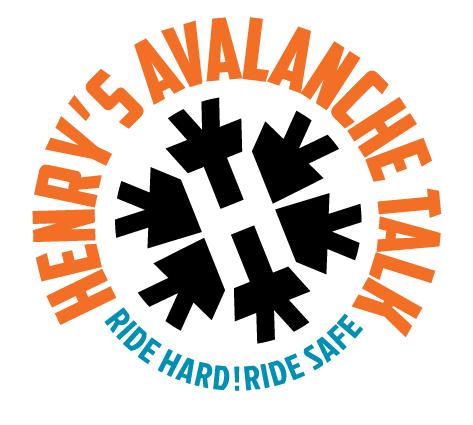
5 minute read
HENRY’S AVALANCHE TALK
SNOW REPORT
Brought to you by Henry’s Avalanche Talk www. henrysavalanchetalk. com It looks like becoming a little more stormy again from Monday to Wednesday with further snowfall expected in the mountains of the Northern French Alps.
Advertisement
The quality of off-piste snow is very varied at the moment. Wind and rain have really affected the surface snow, making it very crusted and difficult to ski in places. In more sheltered spots in the lee and in gullies, there are some excellent strips of powdery off-piste skiing to be found.
A bizarre three days of weather this week will be followed by a calmer weekend and fresh snowfall at the start of next week.
In three days we had drenching rain up to 2700m, followed by a very mild grey and flat light day with slushy snow, followed by a very cold day of monster winds (217km/ hr) that blew the authors shutter off its hinges.
This left us with a weird snowpack. Look at this image taken on 6th Feb of the refrozen shiny crust, also showing rivers of water that had flowed under the snowpack during the warm weather (2500m in Tignes). There was cold dry snow that had fallen at the end of the storm, but it had been blown away by the wind

But at the same time in shady sheltered spots, the powder that fell remained and offered real powder skiing on Wednesday 5th Feb. Fortuntately the weather should settle down this weekend. Shiny crust and water affected snow Tignes 6th Feb – photo Mike Crompton
Because the snow surface varies so much, we really need to keep our concentration as we ski, keeping our eyes open for what’s ahead. After recent storms, there’s also some serious rough avalanche debris out there that is difficult to traverse through.
Recent history of the snowpack Recent high winds, maximum speeds of 217 km/hr on the Pissaillas glacier (above Val d’Isère/Bonneval), have been blowing the snow around (and sometimes off) the mountain.
These winds were accompanied by persistent precipitation, mainly in the form of rain, drenching the snowpack, particularly at 2700 m and below. The wind and rain have caused a lot of the steeper slopes to purge themselves of snow, making for a more stable situation after the initial instability.
Snowpack stability below 2700 m-ish has now vastly improved on all sides of the mountain thanks to this deeply humidified snowpack, followed by consolidation and refreezing during sub-zero temperatures on Tuesday night into Wednesday. Things have now really firmed up, making for a much safer situation as far as avalanches go. The snowpack, at least below 2700/2500 m, is now a lot more stable than it was before the recent episode of persistent rain.
Monday/Tuesday, although the top layer of fresh snow may be unstable in the shortterm, the deeper layers will remain solid due to all this week’s humidification and subsequent refreezing/consolidation. Higher altitudes above 2700 m, which recently received snowfall instead of rain, are not currently so stable because they haven’t been as saturated and consolidated as the lower ones. How does the forecast look for the coming week?
SATURDAY 8: Fairly sunny in the mountains. A few cloud banks of altitude around 4000/6000m. Calm, bright atmosphere. Maximum temperatures: +2°C at 2000m, -3°C at 3000m. Isotherm 0°C: 2400m. Wind at 2000m: calm. Wind at 3000m: SW 10/30 km/h.
What is the current avalanche risk in the Northern French Alps/Savoie? As we write (Thursday 6th Feb) the avalanche risk is a 3/5. We expect it to decrease to 2/5 over the next few days, rising again with any significant amount of fresh snowfall at the beginning of next week.
Check out what the avalanche danger ratings mean. For any specific points about snow stability, you need to check the daily avalanche bulletins, particularly when the fresh snow comes next week.
What does this mean for off-piste skiers and snowboarders? The snowpack, at least below 2500/2700m, has currently become a lot more stable after recent episodes of prolonged rain. Be more wary of the colder higher altitudes where the snowpack has not consolidated as well, and where it has been more windblown. Consult the daily avalanche bulletins for any specific points about snow stability, particularly when the fresh snow comes next week. SUNDAY 9:Sun then clouds. Sun in the morning, becoming cloudy in the afternoon. Maximum temperatures: +3°C at 2000m, -5°C at 3000m. Isotherm 0°C: 1800 then 2300m. Wind at 2000 m: SW 20 then 30/50 km/h. Wind at 3000 m: SW 30 then 50/70 km/h. Night from Sunday to Monday: short rainy period, light snow above 2000/2200m. Stormy W wind in the mountains.
MONDAY 10: A disturbance with grey and rainy weather, rain/snow limit around 2000 then 1500m. Strong W wind at high altitude.
TUESDAY 11: Overcast with snow in the mountains above 1200/1500m. Strong W wind in the mountains.
WEDNESDAY12: Continuation of the disturbed current from the west, rain-snow limit decreasing towards 1000m.
THURSDAY 13: Still cool and unstable, with frequent showers and snow in the mountains from 800/1000m.
Where is most at risk at the moment? Steep slopes with fresh snow on them and terrain traps beneath them are always going to be particularly at risk. Particularly beware of slopes above 2500/2700m, which didn’t benefit from the solidifying effect of the rain’s humidification and subsequent refreezing. Tip of the week Be careful of finding yourself on hard crust that is icy with no grip. There is a lot about. Look for the pockets of soft snow on leeward slopes (SE, E and NE). There is also a lot of avalanche debris from spontaneous avalanches that came down during the changing temperatures and storms. Plan your routes, know where you are going.















